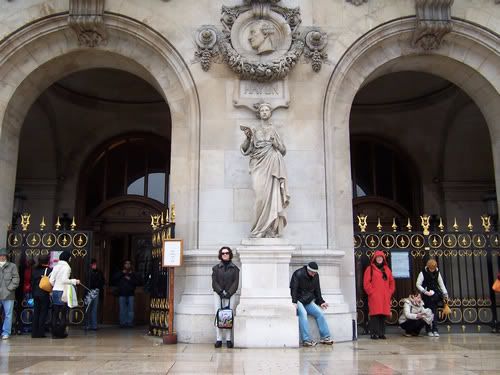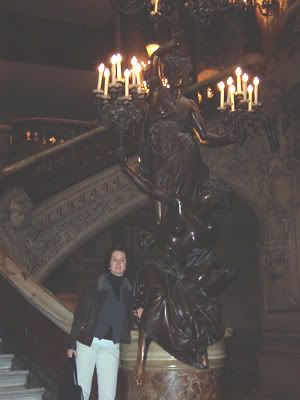Back to our regularly scheduled program...
 ...about the research trip to Paris.
...about the research trip to Paris.So I never finished my travelogue about the Opera Garnier, which is the opera theater that figures in the original Phantom of the Opera, and how the tour was.
(that's me, standing in front of the Opera House on a very cold, dreary, yucky day!)
Well, the tour was great--it was fabulous to be inside the opera house! And, yes, there is a lake under the building--nothing like the one we see in the movie, but there is a lake there. I guess Gaston LeRoux took very appropriate artistic license when he described the Phantom's underground lair and its lake. It's really no more than a very large tank--not that I got to see it.
That was the disappointment of my tour. We got to see pretty much where the patrons would sit or congregate, but nothing backstage or beneath the stage! In that sense, it was very disappointing.
 However, the building itself is magnificent! The grand staircase alone (where the Masquerade scene is in the movie/musical) is made of six different kinds of marble--all different colors, from different geographic locations, and it's just stunning.
However, the building itself is magnificent! The grand staircase alone (where the Masquerade scene is in the movie/musical) is made of six different kinds of marble--all different colors, from different geographic locations, and it's just stunning.(This is a very dim pic of me standing on the grand staircase--Music Man used a flash, but I still had to lighten it up in Photoshop, and this is the best I could do. But you get a sense of the grandeur of the staircase.)
These other pics I had to get from elsewhere--but this is what the interior of the Opera House looked like for real.
 One of the things we learned during our tour was that this was the first theater constructed out of steel, so that it couldn't burn to the ground as so many opera houses and theaters did. So even when the Phantom drops the chandelier in that ending scene of the Webber/Shumacher movie, the Opera House wouldn't have been completely destroyed. Just a little!
One of the things we learned during our tour was that this was the first theater constructed out of steel, so that it couldn't burn to the ground as so many opera houses and theaters did. So even when the Phantom drops the chandelier in that ending scene of the Webber/Shumacher movie, the Opera House wouldn't have been completely destroyed. Just a little! This second, well-lit picture is actually of the boxes. Not the infamous Box Five (which shall be kept empty for the O.G.), because these are the boxes on the right side of the stage--where the women would have sat. The first box actually was made for the Emperor Napoleon III's wife, Eugenie. Her husband would have sat in his box across the stage from her on his own side...the better to flirt with and take notice of the dancers, of course.
This second, well-lit picture is actually of the boxes. Not the infamous Box Five (which shall be kept empty for the O.G.), because these are the boxes on the right side of the stage--where the women would have sat. The first box actually was made for the Emperor Napoleon III's wife, Eugenie. Her husband would have sat in his box across the stage from her on his own side...the better to flirt with and take notice of the dancers, of course.However, neither of them ever attended a performance at the Opera Garnier, for they were overthrown before it was finished!
This picture below shows the chandelier made famous by Webber and his version of the Phantom of the Opera. Yes, the chandelier does fall in the original book, but it's not as magnificent of a disaster, in my opinion, as the way it's portrayed in both the musical and movie done by Webber & Co.

It would have been pretty impossible for the massive light to fall the way it's been described in literature and film because it's held in place by counterweights and a very stable structure. But, in fact, the whole idea of the chandelier falling was based on a real event in which one of the counterweights fell from its moorings and landed on a woman, killing her. There was a fire in the attic of the Opera House, and it melted the steel mooring, thus weakening the cable enough to let the counterweight fall.
So there you have it: some of the myths from The Phantom of the Opera explained!
Now, I have to get back to finishing my version of the story--I'm more than halfway done, so in order to keep the juices flowing, I've gotta post a bit of inspiration here...




0 Comments:
Post a Comment
<< Home